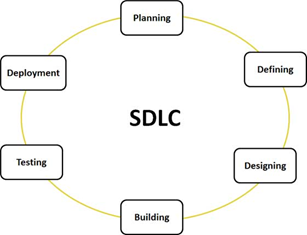The software development life
cycle (SDLC) is a framework defining tasks performed at each step in the
software development process.
SDLC is a process followed
for a software project, within a software organization. It consists of a
detailed plan describing how to plan, design, develop, maintain specific
software product. The life cycle defines a methodology for improving the
quality of software and the overall development process.
The following figure is a graphical representation of the various
stages of SDLC.
Stage 1:
Planning and Requirement Analysis
It is the most important and fundamental stage in SDLC. It is
performed by the senior members of the team with inputs from the customer, the
sales department, market surveys and domain experts in the industry. This
information is then used to plan the basic project approach and to conduct
product feasibility study in the economical, operational, and technical areas.
Planning for the quality assurance requirements and identification
of the risks associated with the project is also done in the planning stage.
The outcome of the technical feasibility study is to define the various
technical approaches that can be followed to implement the project successfully
with minimum risks.
Stage 2:
Defining Requirements
Once the requirement analysis is done the next step is to clearly
define and document the product requirements and get them approved from the
customer or the business analysts. This is done through SRS(Software
Requirement Specification) document which consists of all the product requirements
to be designed and developed during the project life cycle.
Stage 3:
Designing the product architecture
SRS is the reference for product architects to come out with the
best architecture for the product to be developed. Based on the requirements
specified in SRS, usually more than one design approach for the product
architecture is proposed and documented in a DDS(Design Document Specification).
This DDS is reviewed by all the stakeholders and based on various
parameters as risk assessment, product robustness, design modularity , budget
and time constraints , the best design approach is selected for the product.
A design approach clearly defines all the architectural modules of
the product along with its communication and data flow representation with the
external and third party modules (if any). The internal design of all the
modules of the proposed architecture should be clearly defined with the
minutest of the details in DDS.
Stage 4:
Building or Developing the Product
In this stage of SDLC the actual development starts and the
product is built. The programming code is generated as per DDS during this
stage. If the design is performed in a detailed and organized manner, code
generation can be accomplished without much hassle.
Developers have to follow the coding guidelines defined by their
organization and programming tools like compilers, interpreters, debuggers etc
are used to generate the code. Different high level programming languages such
as C, C++, Pascal, Java, and PHP are used for coding. The programming language
is chosen with respect to the type of software being developed.
Stage 5:
Testing the Product
This stage is usually a subset of all the stages as in the modern
SDLC models, the testing activities are mostly involved in all the stages of
SDLC. However this stage refers to the testing only stage of the product where
products defects are reported, tracked, fixed and retested, until the product
reaches the quality standards defined in the SRS.
Stage 6:
Deployment and Maintenance
Once the product is tested and ready to be deployed it is released
formally in the appropriate market. Sometime product deployment happens in stages
as per the organizations business strategy. The product may first be released
in a limited segment and tested in the real business environment (UAT- User
acceptance testing).
Then based on the feedback, the product may be released as it is
or with suggested enhancements in the targeting market segment. After the
product is released in the market, its maintenance is done for the existing
customer base.

No comments:
Post a Comment